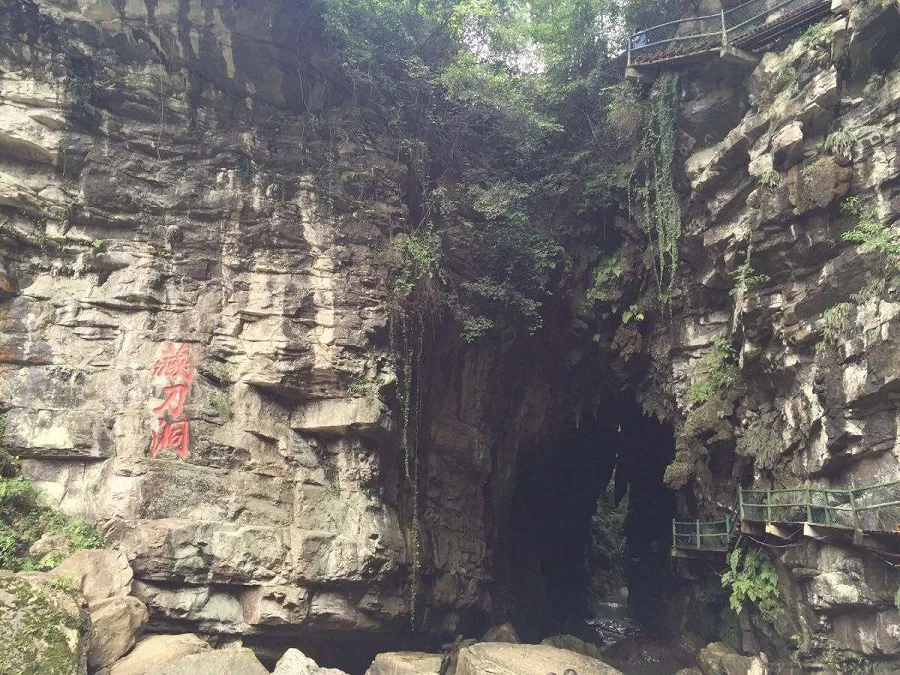Jindao Canyon (金刀峡), located in the Beibei District of Chongqing, is a pristine natural wonder with a history steeped in legend and captivating beauty. Spanning nearly 10 kilometers with an elevation of 880 meters, this canyon has retained its ancient and untouched state over the years, making it a haven for those seeking unspoiled natural landscapes and outdoor adventure.
The name “Jindao” translates to “Golden Knife” in English, and it is derived from a local legend. According to the tale, there is a golden knife hidden within the canyon, and during the nighttime, its radiant golden glow illuminates the entire ravine, thus giving rise to the name “Jindao Canyon.” This mystical legend adds an element of enchantment to the already picturesque landscape.
Jindao Canyon is characterized by its rugged terrain, towering mountains, pristine waterways, numerous waterfalls, and azure pools. It can be divided into two segments: the upper and lower canyon. The upper canyon features a landscape of deep gorges and valleys, all interspersed with crystal-clear streams. In contrast, the lower canyon is replete with caves, deep pools, and waterfalls cascading down steep cliffs. When compared to the nearby Heishangu (Black Mountain Valley), Jindao Canyon is even more perilous, with steeper and more challenging paths. Due to its remote location and adventurous nature, the number of visitors is relatively low, making it an ideal destination for outdoor enthusiasts and those with a penchant for exploration.
Table of Contents
- Basic Information
- Location and Transportation
- Highlights of Jindao Canyon
- Vlog about Jindao Canyon Scenic Area
- Useful Tips Summarized from Reviews
- Other Natural Sceneries in Chongqing Suburb
Basic Information
| Website | http://www.chongqingjindaoxia.com/ |
| Estimated Length of Tour | Half a day |
| Ticket Price | Admission: 80 RMB Admission + Boat Cruise + Cable Car: 198 RMB |
| Shuttle Bus | 25 RMB |
| Opening Hours | 8.00 – 16.00 |
| Telephone Number | 0086-023-63602777 |
Location and Transportation
Jindao Canyon is situated in the town of Jindaoxia, within the Beibei District of Chongqing, China. This picturesque location is nestled at the southwestern foothills of Huaying Mountain, approximately 90 kilometers away from the heart of Chongqing city. It is also about 62 kilometers from the Beibei urban area.
To get to Jindao Canyon, you can take a long-distance bus from Chongqing Nanping Long-Distance Bus Station or from Chongqing Hotel near Jiefangbei. These buses will take you to Beibei. Once you reach the final stop in Beibei, you can transfer to Bus Route 22, which will take you directly to Jindao Canyon.
Highlights of Jindao Canyon
Sky-Soaring Waterfall

One of the standout attractions in Jindao Canyon is the “Xuantian Feipu,” which translates to the “Sky-Soaring Waterfall.” Situated on the right side of the upper entrance to Jindao Canyon, the Xuantian Feipu is a mesmerizing sight. It is perched on the cliff of the mountain, rising almost vertically into the sky. A silvery-white cascade of water plummets from the heavens, with a height of approximately 150 meters and a width of around 10 meters. To the left of the waterfall, there is a square-shaped cave, its origins shrouded in mystery. Local folklore recounts the tale of a wise old Taoist who once meditated within this cave for many years. Upon achieving enlightenment, the Taoist ascended to become an immortal, departing on a rainbow on a clear noon after a prolonged rainfall.
Hidden Knife Cave

Another intriguing spot within the canyon is the “Cangdao Dong,” or the “Hidden Knife Cave.” Legend has it that this is the place where General Zhang Kun of the Daxia Kingdom discovered the legendary golden knife. The interior of the cave is adorned with peculiar stalactite formations, with one stalactite in particular resembling an empty knife sheath, plunging straight into the rocky walls of the ravine. The cave stands at a height of over 50 meters, with varying widths of 10 meters at its broadest and 7-8 meters at its narrowest. Its geological formation is a marvel in itself, created through the movement of the Earth’s crust millions of years ago.
Divine Eagle Ravine

Further up the canyon, you’ll encounter the “Shenying Xia,” or the “Divine Eagle Ravine.” This natural wonder lies at the entrance of the upper segment of Jindao Canyon. On the right side, you’ll be greeted by an awe-inspiring rock formation that resembles a massive eagle’s beak thrusting into the void. Here, pristine spring water flows down from the eagle’s beak, providing a refreshing and cool atmosphere in the midst of the canyon’s formidable cliffs.
Vlog about Jindao Canyon Scenic Area
Useful Tips Summarized from Reviews
Food and Refreshments: Along the way, there are places to eat, but the food is both expensive and not very tasty. It’s advisable to bring your own snacks and drinks to avoid relying on the food available in the area.
Transportation and Parking: For visitors traveling by car, it’s recommended to park the car at the South Gate at the foot of the mountain. From there, take the shuttle bus to the North Gate to enter the scenic area. The shuttle bus costs 25 yuan per person. After exploring the scenic area, exit at the South Gate, where you can directly return to your car and drive home.
Cangdao Cave (藏刀洞): The road leading down to Cangdao Cave is relatively narrow, which may not be very friendly for slightly overweight individuals. However, children can enjoy playing in the water here.
Boat Ride: In the middle section of the canyon, there is a segment where visitors can take a boat ride for 10 yuan per person. If you choose not to take the boat, you can detour around from the mountain. It’s highly recommended to experience the boat ride as it offers a unique perspective of the canyon. The narrowest part of the canyon is only about two meters wide, providing a serene and picturesque experience as you glide through the water.






